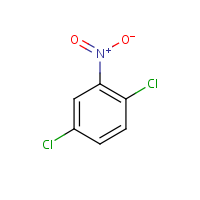1,4-Dichloro-2-nitrobenzene
Agent Name
1,4-Dichloro-2-nitrobenzene
CAS Number
89-61-2
Formula
C6-H3-Cl2-N-O2
Major Category
Nitrogen Compounds

Synonyms
1-Nitro-2,5-dichlorobenzene; 2,5-Dichlornitrobenzen [Czech]; 2,5-Dichloronitrobenzene; 2,5-Dichloronitrobenzol; Benzene, 2,5-dichloronitro-; Nitro-p-dichlorobenzene; Benzene, 1,4-dichloro-2-nitro-; [ChemIDplus] 1,4–Dichlor–2–nitrobenzol; 1,4–Dichloro–3–nitrobenzene; 2,5–DCNB; 2,5–Dichlor–1–nitrobenzol; Benzol, 1,4–dichlor–2–nitro–; Nitro–p–dichlorbenzol; Nitro–p–dichlorobenzol; Nitro–p–diclorobenceno; p–Dichlornitrobenzol; [IUCLID] UN1578
Category
Nitros, Aromatic
Description
Yellow solid; [ICSC] Yellow crystals; [Sigma-Aldrich MSDS]
Sources/Uses
Used as an intermediate in the chemical industry; [IUCLID] Used to make pigments, pesticides, and UV absorbents; [HSDB]
Comments
No listed effects of short-term or long-term exposure (health effects have not been fully investigated); [ICSC] Can possibly induce methemoglobinemia; Can be absorbed through skin; Not a skin or eye irritant in rabbits; Not sensitizing in guinea pig maximization tests; No mortalities in rats exposed by inhalation to 47.6 mg/m3 for 7 hours; Increased liver weight (accompanied by hepatocellular hypertrophy), damage to the forestomach, increased bilirubin levels, and adverse male reproductive effects (depressed spermatogenesis) observed in 28-day oral study of rats; Cyanosis and methemoglobin formation observed in cats; [IUCLID] A mild skin and strong eye irritant; May induce methemoglobinemia; Harmful by ingestion and skin absorption; [Sigma-Aldrich MSDS] See "3,4-Dichloronitrobenzene."
Biomedical References
Exposure Assessment
Vapor Pressure
0.00505 mm Hg
Explanatory Notes
The Guide in the Emergency Response Guidebook is for "Chloronitrobenzenes, solid."
Adverse Effects
Methemoglobinemia
MetHgb is secondary toxic effect
Hepatotoxin
Hepatoxic (a) from occupational exposure (secondary effect) or (b) in animal studies or in humans after ingestion
IARC Carcinogen
Possible (2b)
Diseases, Processes, and Activities Linked to This Agent
Other Information
No other related information on this agent was found.